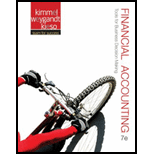
Concept explainers
(a)
Accounts receivable refers to the amounts to be received within a short period from customers upon the sale of goods, and services on account. In other words, accounts receivable are amounts customers owe to the business. Accounts receivable is an asset of a business.
Bad debt expense:
Bad debt expense is an expense account. The amounts of loss incurred from extending credit to the customers are recorded as bad debt expense. In other words, the estimated uncollectible accounts receivable are known as bad debt expense.
Allowance method:
It is a method for accounting bad debt expense, where uncollectible accounts receivables are estimated and recorded at the end of a particular period. Under this method,
Write-off:
Write-off refers to deduction of a certain amount from accounts receivable, when it becomes uncollectible.
To record: The
(b)
the balance in allowance for doubtful accounts and accounts receivable using T-account.
(c)
To prepare: The
(d)
To compute: The accounts receivable turnover and average collection period.
Want to see the full answer?
Check out a sample textbook solution
Chapter 8 Solutions
Financial Accounting
- QUESTION 1 Rentokil Limited issued a 10-year bond on January 1 2011. It pays interest on January1. The below amortization schedule and interest schedule reflects this. Its year end isDecember 31. Requirements: a) Indicate whether the bonds were issued at a premium or a discount and explainhow you came to your decision. b) Compute the stated interest rate and the effective interest rate c) Prepare the journal entries for the following years:I. 2011, 2012 & 2018.arrow_forwardBlueberry Corp. plans to tighten its credit policy. The new policy will decrease the average number of days in collection from 65 to 45, as well as reduce the ratio of credit sales to total revenue from 80% to 70%. The company estimates that projected sales will be 8% less if the proposed new credit policy is implemented. The firm’s short-term interest cost is 8%. Projected sales for the coming year are $32,000,000. Assuming a 360-day year, calculate the dollar impact on accounts receivable of Blueberry Corp. of this proposed change in credit policy.arrow_forwardCrane Company accumulates the following data concerning a mixed cost, using units produced as the activity level. Units Produced Total Cost March 9,970 $20,005 April 8,930 18,154 May 10,500 20,538 June 8,710 17,674 July 9,370 18,604 Using the information from your answer to above part, write the cost equation. (Round per unit produced answer to 2 decimal places (e.g., 2.25).) +A +$ per unit produced × Total costarrow_forward
- On the 5th of the month, Greg Marketing pays its field sales personnel a 3% commission on the previous month's sales. Sales for March 2016 were $1,200,000. What is the entry at the end of March to record the commissions? A. Debit Sales - 36,000$; Credit Sales Commission Expense - 36,000$ B. Debit Sales Commission Expense - 36,000$; Credit Sales Commissions Payable - 36,000$ C. Debit Sales Commission Expense - 36,000$; Credit Accounts Receivable - 36,000$ D. Debit Sales -36,000$; Credit Sales Commission Income - 36,000$arrow_forwardNet profit is calculated in which of the following account? A) Profit and loss account B) Balance sheet C) Trial balance D) Trading accountarrow_forwardThe debts which are to be repaid within a short period (a year or less) are referred to as, A) Current Liabilities B) Fixed liabilities C) Contingent liabilities D) All the abovearrow_forward

 AccountingAccountingISBN:9781337272094Author:WARREN, Carl S., Reeve, James M., Duchac, Jonathan E.Publisher:Cengage Learning,
AccountingAccountingISBN:9781337272094Author:WARREN, Carl S., Reeve, James M., Duchac, Jonathan E.Publisher:Cengage Learning, Accounting Information SystemsAccountingISBN:9781337619202Author:Hall, James A.Publisher:Cengage Learning,
Accounting Information SystemsAccountingISBN:9781337619202Author:Hall, James A.Publisher:Cengage Learning, Horngren's Cost Accounting: A Managerial Emphasis...AccountingISBN:9780134475585Author:Srikant M. Datar, Madhav V. RajanPublisher:PEARSON
Horngren's Cost Accounting: A Managerial Emphasis...AccountingISBN:9780134475585Author:Srikant M. Datar, Madhav V. RajanPublisher:PEARSON Intermediate AccountingAccountingISBN:9781259722660Author:J. David Spiceland, Mark W. Nelson, Wayne M ThomasPublisher:McGraw-Hill Education
Intermediate AccountingAccountingISBN:9781259722660Author:J. David Spiceland, Mark W. Nelson, Wayne M ThomasPublisher:McGraw-Hill Education Financial and Managerial AccountingAccountingISBN:9781259726705Author:John J Wild, Ken W. Shaw, Barbara Chiappetta Fundamental Accounting PrinciplesPublisher:McGraw-Hill Education
Financial and Managerial AccountingAccountingISBN:9781259726705Author:John J Wild, Ken W. Shaw, Barbara Chiappetta Fundamental Accounting PrinciplesPublisher:McGraw-Hill Education





